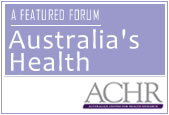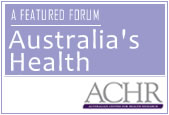Bedfellows or Combatants: the balance between innovating health technology and maximising the value of the health dollar
Deborah Waterhouse | December 21, 2009

My name is Deborah Waterhouse and I am the General Manager of Glaxosmithkline (GSK) Australasia. I would like to thank GAP for inviting me to speak today.
The title I have chosen is Bedfellows or Combatants: the balance between innovating health technology and maximising the value of the health dollar.
I want to briefly present the challenges facing governments and the pharmaceutical industry and propose that we have a choice to make as to how we want to work together.
Increasingly healthcare payers want to see proof of the value of the health outcomes they are purchasing, particularly in an environment of budgetary restraint.
Furthermore they want a greater focus on prevention than past models of intervention,and they want healthcare solutions rather than just a “product” to treat an illness.
The demand for effective healthcare solutions is rising as the population ages, new medical needs emerge and treatment options expand. As a result it is important to ensure that as a community we are obtaining value from the significant investment in “health” not only in terms of the health outcomes sought but in the broader economic
sense of a more productive and healthier workforce.
& For many years investment in health, being a good thing, has been taken as read and therefore increased expenditure on health is seen as more of a good thing. It is only in the last decade or two that many developed economies have started looking with increased focus at the value obtained for the dollars spent on health.
For many years investment in health, being a good thing, has been taken as read and therefore increased expenditure on health is seen as more of a good thing. It is only in the last decade or two that many developed economies have started looking with increased focus at the value obtained for the dollars spent on health.
 For many years investment in health, being a good thing, has been taken as read and therefore increased expenditure on health is seen as more of a good thing. It is only in the last decade or two that many developed economies have started looking with increased focus at the value obtained for the dollars spent on health.
For many years investment in health, being a good thing, has been taken as read and therefore increased expenditure on health is seen as more of a good thing. It is only in the last decade or two that many developed economies have started looking with increased focus at the value obtained for the dollars spent on health.In many respects the healthcare industry has struggled to come to grips with this new paradigm where proof of improved health outcomes is required, particularly in respect to the value of new products, devices, technology etc. Furthermore the existing focus is on treatment of the disease rather than prevention and Governments face the dilemma that a continued focus on treatment will be unsustainable.
My industry, the pharmaceutical industry, seems to have been the initial focus in many countries of this greater financial scrutiny; perhaps because it is often an uncapped budget allocation, something worldwide that the Ministries of Treasury or Finance dislike. Demonstrating the value of innovation has applied in the pharmaceutical
sector in Australia for nearly 20 years via the evaluation process of the Pharmaceutical Benefits Advisory Committee (PBAC).
As the population ages and the health sector takes an increasing slice of Government budget the complexity of meeting competiting demands increases exponentially as highlighted by the recommendations from the various health reviews conducted over the last few years.
From Minister Roxon’s recent comments it is apparent that in redesigning the Australian health system the costs of any new initiatives will at least in part have to be met by savings from within the Health portfolio. To quote, “this means that any health reforms we want to implement will need to be balanced by the means to fund them. We will need to make tough choices about what our priorities are for health reform, and what we will do to fund these reforms.”
Furthermore the Minister noted that the Government was and I quote, “…looking at PBS and Medical Benefits Schedule (MBS) funded procedures and medicines to make sure they maintain clinical effectiveness and value for the taxpayer”.
It is such issues where the subject of being either bedfellows or combatants comes to the fore.
In the pharma industry the traditional response has been one of opposition to any change, particularly a tightening of reimbursement arrangements. The industry’s argument has been to say that, funding changes will impact innovation but the two sides have rarely spoken the same language.
The extent of the gap in approaches is highlighted by recent comments from Pricewaterhouse Coopers that I quote, “payers define breakthroughs as a way to improve public health at lower costs whereas industry defines breakthrough as new innovation".
Industry should be a crucial part of the discussion with the Government in determining what is the value of proposed healthcare solutions and what health outcomes are possible. We must move from the old model of simply being a provider of an input to one of providing a real understanding of the benefits of new technology via increased information sharing between industry and government as to what theyare buying. This will require a more sophisticated and open level of discussion and more risk sharing. GSK is taking the lead in looking at news ways of working with Government to develop these common understandings. I would hope that I can demonstrate that it is possible to be bedfellows such that innovation is supported and the Government obtains improved health outcomes.
Whilst most elements of the healthcare sector are subject to pressures for change both externally and internally probably no sector is subject to more pressure for change than in the pharma industry. Within the industry, issues around declining R&D productivity (with the cost of a new drug exceeding $1bl) and a pending patent cliff ($200bl worth of products coming off patent in next four years) are causing considerable industry restructuring. Over-riding this has been the global financial crisis which has resulted in every government in the world focussing on the costs of government and health costs are high on this list.
No industry sector is more research intensive than the pharmaceutical and biotechnology sector with companies spending on average well in excess of 10% of turnover on R&D. Six of the top ten global companies in terms of R&D expenditure are from the pharma sector. In many developed countries the industry is by far the largest employer of scientists and in Australia alone provides over 14,00 highly skilled, well paying jobs.
As I mentioned previously estimates are that it takes up to 13 years and in excess of $1bl in development costs to bring a new medicine to market. At best you have 20 years of patent life and as our previous CEO JP Garnier commented in 2007 “This is a business model where you are guaranteed to lose your entire book of business every 10 to 12 years”.
Of every 1 molecule that comes to market 10,000 fall by the wayside in the development and clinical trial process. This also highlights the unprecedented nature of the risk of R&D in the pharma sector. However the industry has been prepared to sustain levels of research on the basis of a fair return on this investment.
The breakthrough treatments we are seeing for a range of chronic diseases and increasingly in areas such as oncology and neurology are only occurring because industry is obtaining a return on its investment. The innovation that originally may have started as providing an extra few months of life 20 years ago has in many cases now developed into offering life saving or significantly life extending medicines.
Twenty five years ago HIV was a death sentence, but sustained innovation by industry with the support of Government now means for many sufferers it is a chronic disease rather than terminal.
At same time industry’s R&D productivity in steep decline – last year over $50bl was spent on R&D and less than 20 NCE were approved by FDA – in 1982 less than $US2bl was spent on R&D for same number of NCEs approved.
So the pharma industry is facing many internal challenges and at the same time it is under unprecedented pressure from Governments of all persuasions across the world to lower prices. This has taken the form of non-approval of news drugs, price caps, reduced prices, targeted patient populations, rebates etc.
Australia has actually led the world in the rigorous evaluation approach introduced in the early 1990 for the PBS in using a mixture of economic and health disciplines to maximise the value of a dollar spent in the health arena. It falls under the broad umbrella of Health Technology Assessment.
Decisions on PBS listing are made on a health economics perspective, with a costbenefit
analysis determining whether the cost of the medication to the community justifies the benefit and involves such termination as QALYs.
In essence therefore the decision to fund an intervention via a medicine is based on a decision around innovation (ie the benefit it provides) versus the cost. Now some of my colleagues in the pharma industry will argue that because in Australia the PBAC acts as a single purchaser it is effectively drives prices down. A report last year revealed that the prices the Australian government pays pharmaceutical companies for new medicines are on average 19% lower than the OECD average. However these arrangements have not prevented the entry of innovative drugs to the Australian market.
Medicines and vaccines are the only areas within the health sector where health interventions are subject to cost effectiveness evaluation but I believe in the future this has to change.
Now as has been discussed previously we are entering an environment where the Government is conscious of the need to restrain expenditure and this won’t just apply to the pharma industry as demonstrated by approaches with cataracts etc.
In the past, the model within the Pharma industry has been to develop a new medicine based on what our colleagues have been able to discover within R&D. Often the resultant product is a “me too” and not the first in its class – it is one of many treatments for a particular disease category. Again often these products are developed in isolation from the payor such as the PBAC The first time the payor is aware of the new drug is when the company makes a submission for funding approval. If it is another “me too drug” often the company will be offered a price equivalent to that paid for products already on market which could be a generic price GSK believes that the industry needs to have more honest engagement with government around what is the value proposition of the product and rather than just answering for ourselves hear feedback from the customers. Within GSK we have made a number of significant changes around the focus of making the value proposition explicit.
In both Europe and the US we have initiated meetings with representatives of the payors and our own researchers to start discussing at the molecule stage the value of our new discoveries. Before I left Europe I was involved in the setting up a round table with the heads of NICE, Transparency Commission, IQWIG and regional HTAleads from Spain and Italy. GSK R&D heads from a 6 therapy areas presented PII pipeline product to the group for critique. It was an enlightening day when the excitement of the scientist met with the realism of the payor. The dialogue was invaluable in shaping the development programme of those medicines but also setting
a realistic expectation of the likely level of reimbursement.
These discussions mitigate some of the risk around innovation by obtaining early stage feedback on perceptions of value. It also provides the government with an early insight as to a future healthcare solution.
Another change we have implemented relates to how we incentivise our researchers. In the past their remuneration and bonuses have been tied to developing new drugsand not at all related to their reimbursement or market access. Today their remuneration is tied to delivering what we call a reimburseable product – one that governments value and will pay for. It ensures researchers are looking at meeting unmet needs and providing data to demonstrate the level of cost effectiveness provided.
As PWC noted increasingly the price any therapy can command will be based on its performance not the claims of its manufacturer. In the UK this has lead to recommendations that the British medicines pricing scheme should move from its current “profit cap and price cap” to a value based pricing system in which prices are set by comparing their clinical value with that of other treatments for the same condition.
We are also seeing a much greater focus on risk sharing arrangements where the supplier needs to assume a much greater share of the financial risk and this is something we are already doing in Australia.
To ensure that the return for investment is not lost in this process then industry and government need to start discussing at an earlier stage issues such as the value proposition and obtain real payor feedback.
As an industry we also need to work on building trust with the Government and community because if we want to have these discussions into the future can only happen on basis of trust and mutual engagement.
We need to adopt a new mindset. We in big pharma should never take for granted our right to exist; our business model is not written into any country’s constitution. So we should be turning up to work every day with the mindset that we are earning the right to exist. We are earning it by meeting the expectations of society. When you start to think like this, you see the world differently.
It is possible to be bedfellows in the new environment but this can only happen if industry collaborates more with Government and the government is open to that collaboration.
SHARE WITH:













